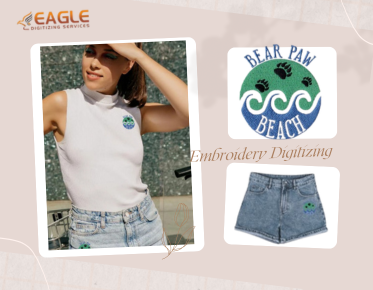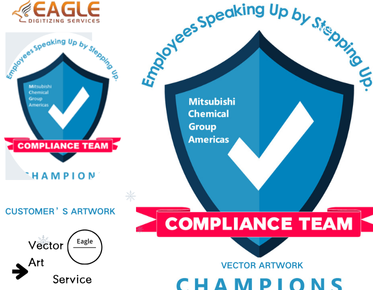How can you turbocharge your embroidery sales from eagle digitizing?
In a world where digitized embroidered products are gaining popularity, finding effective ways to market these items is essential for success. From understanding your audience to leveraging the latest digital marketing trends, there are myriad strategies to elevate your brand and reach potential customers. This guide will explore the comprehensive steps necessary to effectively market your digitized embroidered products and stand out in a competitive marketplace.
Understanding
the Market for Digitized Embroidery
Exploring the Popularity of
Embroidery
Embroidery has a rich history, transcending time and trends to become
a beloved craft. In recent years, the digitized embroidery sector has
experienced a renaissance, merging traditional techniques with modern
technology. This fusion has broadened its appeal, making it accessible to a new
generation of craft enthusiasts and fashion-forward consumers. The tactile
quality, bespoke nature, and personalized touch of embroidered items resonate
deeply with those seeking unique, high-quality products.
Who Are Your Potential
Customers?
Your potential customers are as diverse as the designs you create. They include fashion aficionados, home decor enthusiasts, and corporate clients looking for customized merchandise. Understanding the demographics and psychographics of these groups—such as their age, interests, and spending habits—can help tailor your marketing efforts. Identifying your niche market, whether it's millennials who appreciate bespoke fashion or businesses needing branded merchandise, will refine your strategies and enhance engagement.
Building
Your Brand Identity
Crafting a Unique Brand Story
Your brand story is the narrative that conveys your values, mission,
and what makes your products unique. It’s not just about what you sell, but why
you sell it. Perhaps your passion for embroidery started as a family tradition,
or maybe your products support a cause. Crafting a compelling brand story can
forge an emotional connection with customers, making them more likely to
support your brand.
Designing a Memorable Logo and
Brand Elements
A memorable logo and cohesive brand elements are crucial for recognition. Your logo should reflect the essence of your brand—whether it’s elegant, playful, or artisanal. Consistent use of colors, fonts, and imagery across all marketing materials reinforces your brand identity and makes your business instantly recognizable.
Creating
High-Quality Digitized Embroidered Products
Choosing the Right Materials and
Techniques
The quality of your products begins with the materials and techniques
you use. Opt for high-grade fabrics and threads that ensure durability and
vibrancy. Mastering various embroidery techniques, from satin stitches to
French knots, can add dimension and sophistication to your designs, setting
your products apart from the competition.
Ensuring Quality Control
Quality control is vital to maintain your brand’s reputation. Implement rigorous checks at every production stage, from design digitizationto the final stitch. Addressing issues such as thread tension and alignment ensures that each piece meets your high standards and satisfies customer expectations.
Setting
Up an Online Store
Selecting the Best E-commerce
Platform
Choosing the right e-commerce platform is critical for your business’s
success. Platforms like Shopify, WooCommerce, and Etsy offer various features
tailored to different needs. Consider factors such as ease of use,
customization options, payment processing, and customer support when making
your decision.
Creating an Engaging Website
Design
Your website design should be visually appealing and user-friendly. Use high-quality images, intuitive navigation, and clear calls to action to enhance the user experience. An engaging website design not only attracts visitors but also encourages them to explore and purchase your products.
Optimizing
Your Website for SEO
Understanding SEO Basics for
E-commerce
Search Engine Optimization (SEO) is key to increasing your online
visibility. Understand the basics of SEO, including how search engines rank
websites and the importance of keywords. An optimized website attracts more
organic traffic, leading to higher sales.
Using Keywords Effectively
Keywords are the terms and phrases potential customers use to find products like yours. Conduct keyword research to identify high-volume, relevant keywords. Incorporate these into your product descriptions, blog posts, and meta tags to improve your search engine rankings.
Leveraging
Social Media Marketing
Choosing the Right Social Media
Platforms
Not all social media platforms are created equal. Identify where your
target audience spends their time. Instagram and Pinterest are ideal for
visually appealing products like embroidered items, while Facebook and Twitter
can be useful for engaging with a broader audience and sharing updates.
Crafting Engaging Social Media
Content
Create content that resonates with your audience. Share behind-the-scenes looks at your design process, customer testimonials, and user-generated content. Use a mix of photos, videos, and stories to keep your feed dynamic and engaging.
Building
an Email Marketing Strategy
Growing Your Email List
An email list is a valuable asset. Encourage website visitors to
subscribe by offering incentives like discounts or free guides. Use sign-up
forms on your website and social media to grow your list organically.
Creating Eye-Catching
Newsletters
Newsletters should be visually appealing and informative. Use a mix of
images and text to keep readers engaged. Share news about new products, upcoming
sales, and behind-the-scenes stories to keep your audience interested and
informed.
Collaborating
with Influencers
Finding the Right Influencers
for Your Brand
Influencer marketing can significantly boost your visibility. Look for
influencers with a following that matches your target demographic.
Micro-influencers, with their loyal followings, can be very effective.
Negotiating Partnerships and
Collaborations
Approach potential influencers with a clear proposal. Outline the benefits of collaboration and what you can offer in return. Negotiating fair compensation and clear deliverables ensures a successful partnership.
Utilizing
Visual Content
Creating Stunning Product Photos
High-quality photos are crucial for online sales. Use good lighting,
clear backgrounds, and multiple angles to showcase your products. Professional
photography can make a significant difference in how your products are
perceived.
Making Engaging Videos and
Tutorials
Videos are highly engaging and can showcase your products in action. Create tutorials on how to use or style your embroidered items, or share the story behind your brand. Engaging videos can captivate your audience and encourage them to make a purchase.
Running
Paid Advertising Campaigns
Understanding Different Types of
Paid Ads
Paid advertising can boost your visibility quickly. Understand the
different types of ads, including pay-per-click (PPC), social media ads, and
display ads. Each has its advantages and can be used to target different stages
of the customer journey.
Creating Effective Ad Copy and
Visuals
Your ad copy and visuals must capture attention and drive action. Use compelling headlines, clear calls to action, and eye-catching images. A/B testing multiple versions can help determine which performs best.
Engaging
with Online Communities
Participating in Relevant Forums
and Groups
Join forums and groups related to embroidery and crafts. Participate
actively by sharing your expertise, answering questions, and offering helpful
advice. Engaging with these communities can build your reputation and attract
potential customers.
Hosting Virtual Events and
Workshops
Virtual events and workshops are excellent ways to showcase your expertise and connect with your audience. Host embroidery tutorials, Q&A sessions, or virtual trunk shows to engage with your audience in real time.
Offering
Promotions and Discounts
Creating Limited-Time Offers
Limited-time offers create a sense of urgency and encourage quick
purchases. Promote these offers through your website, social media, and email
campaigns to drive sales.
Using Discount Codes to Drive
Sales
Discount codes are effective in attracting new customers and retaining existing ones. Offer exclusive codes for first-time buyers or special occasions to incentivize purchases.
Expanding
to Offline Markets
Participating in Craft Fairs and
Markets
Craft fairs and markets provide an excellent opportunity to showcase
your products in person. Engage with potential customers, get direct feedback,
and build brand awareness in a tactile environment.
Collaborating with Local
Boutiques
Partnering with local boutiques can expand your reach to customers who prefer in-person shopping. Select boutiques that align with your brand values and aesthetic for a cohesive partnership.
Utilizing
Content Marketing
Writing Engaging Blog Posts
Blog posts are a great way to share your knowledge and drive traffic
to your website. Write about topics related to embroidery, offer tips and
tutorials, and share behind-the-scenes stories to engage your audience.
Creating Informative Guides and
Tutorials
Guides and tutorials can position you as an expert in your field. Offer detailed, step-by-step instructions on various embroidery techniques or care tips for embroidered items to provide value to your customers.
Maximizing
Customer Reviews and Testimonials
Encouraging Customers to Leave
Reviews
Positive reviews build trust and influence purchasing decisions.
Encourage satisfied customers to leave reviews by making the process simple and
offering incentives such as discounts on future purchases.
Displaying Testimonials on Your
Website
Showcase testimonials prominently on your website. Highlight quotes that speak to the quality, uniqueness, and satisfaction of your products. Testimonials act as social proof, reassuring potential customers of their purchase.
Implementing
a Customer Loyalty Program
Designing a Reward System
A well-designed reward system can incentivize repeat purchases. Offer
points for every purchase, referral, or social media share, which can be
redeemed for discounts or exclusive products.
Promoting Your Loyalty Program
Promote your loyalty program through your website, social media, and email campaigns. Clearly communicate the benefits and how customers can join to encourage participation.
Analyzing
and Adjusting Your Marketing Strategy
Using Analytics Tools to Track
Performance
Analytics tools are vital for tracking the effectiveness of your
marketing campaigns. Use platforms like Google Analytics, social media
insights, and e-commerce analytics to gather data on traffic, engagement, and
sales.
Identifying What’s Working and
What’s Not
Analyze the data to identify which strategies are effective and which are not. Look for patterns and trends that can inform your future marketing efforts, allowing you to focus on what drives results.
Staying
Ahead of Industry Trends
Keeping Up with New Technologies
in Embroidery
The embroidery industry is constantly evolving. Stay informed about
new technologies and techniques that can enhance your products and streamline
production processes.
Adapting to Changes in Consumer
Behavior
Consumer behavior can shift rapidly. Stay agile by monitoring trends and adapting your marketing and product offerings to meet changing demands.
Marketing digitized embroidered products requires a multifaceted
approach. By understanding your market, building a strong brand identity,
leveraging digital marketing strategies, and staying ahead of industry trends,
you can effectively reach and engage your target audience. Start implementing
these strategies today and watch your business thrive in the vibrant world of
digitized embroidery. Embrace the journey, stay creative, and continue to
innovate for future success.Read Here are Some Things That You Should Know When It Comes To Embroidery Digitizing!



.png)